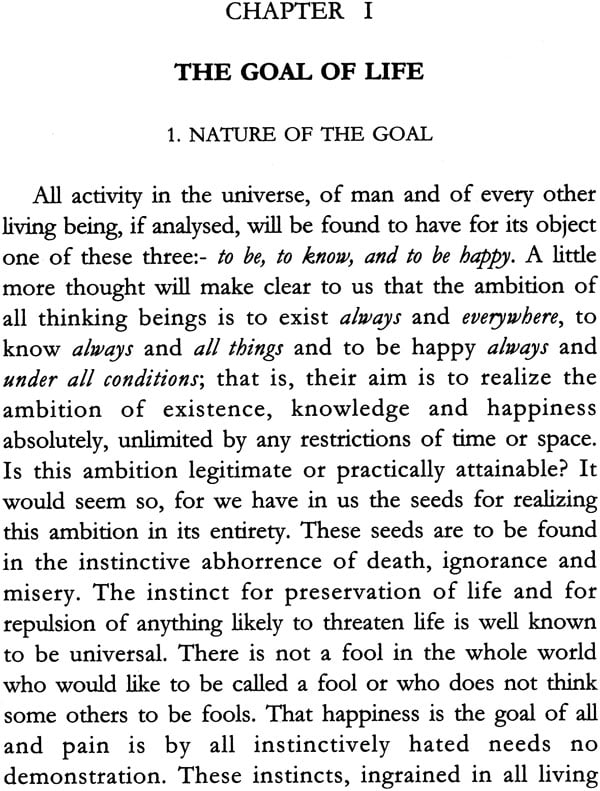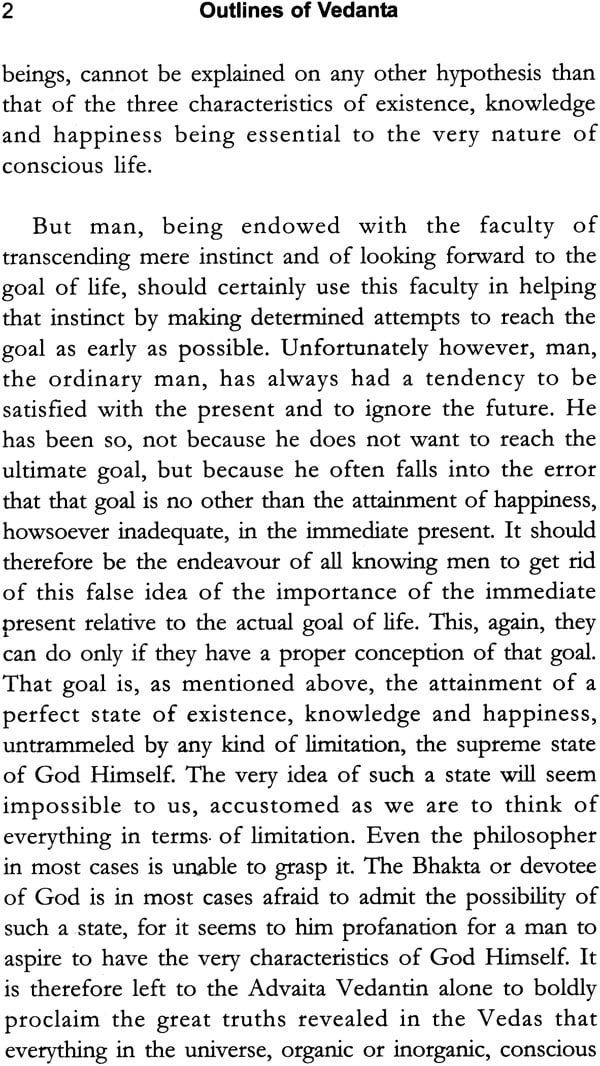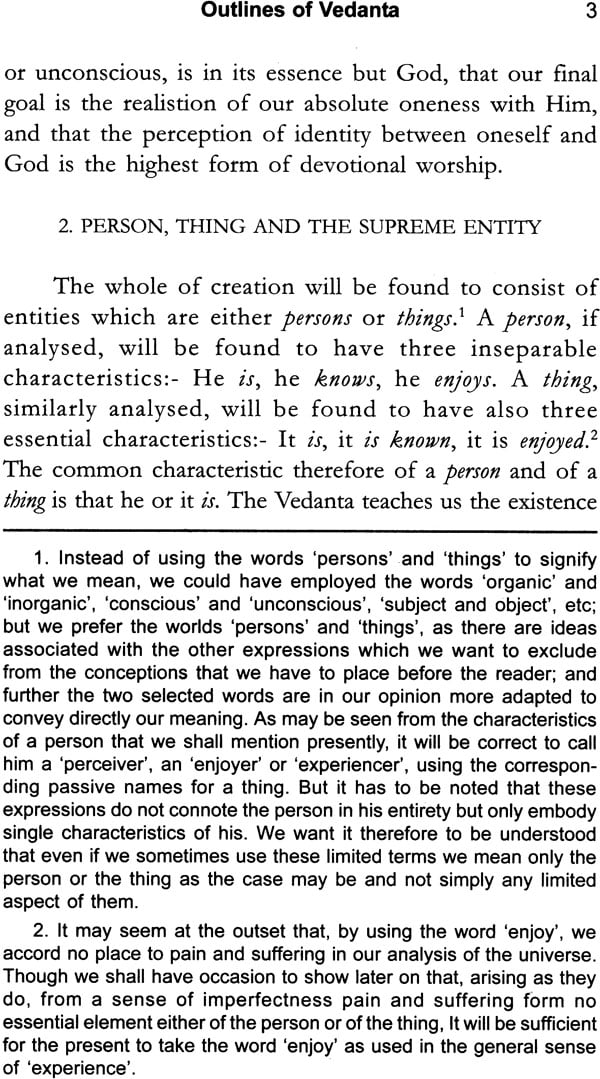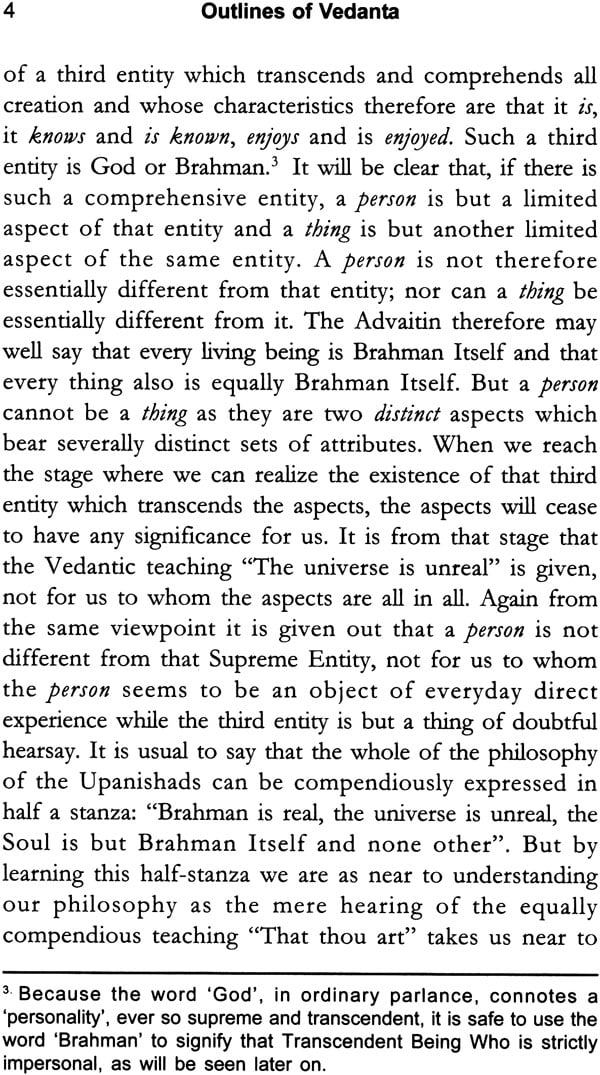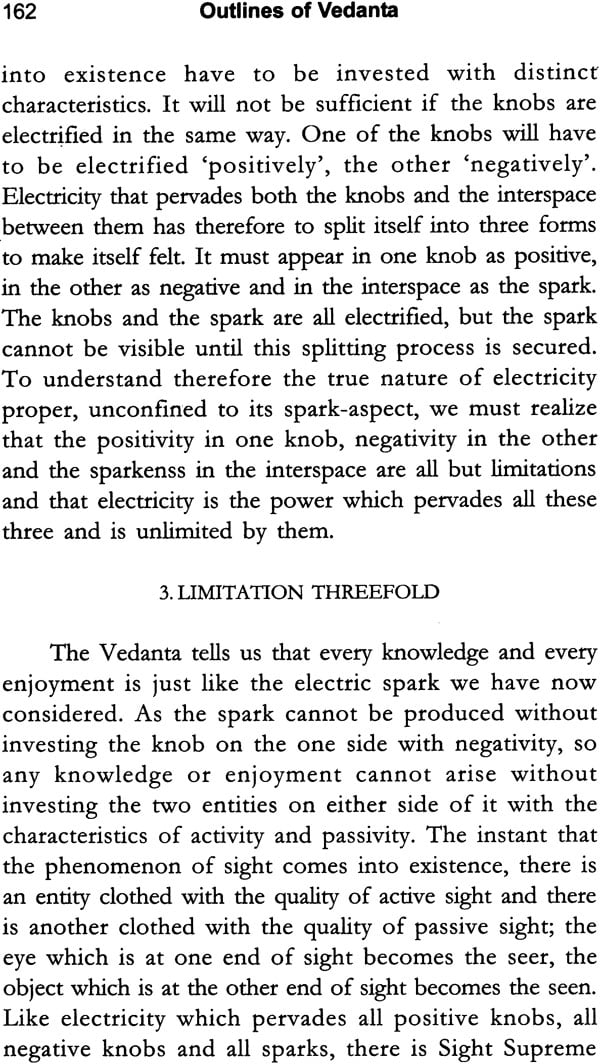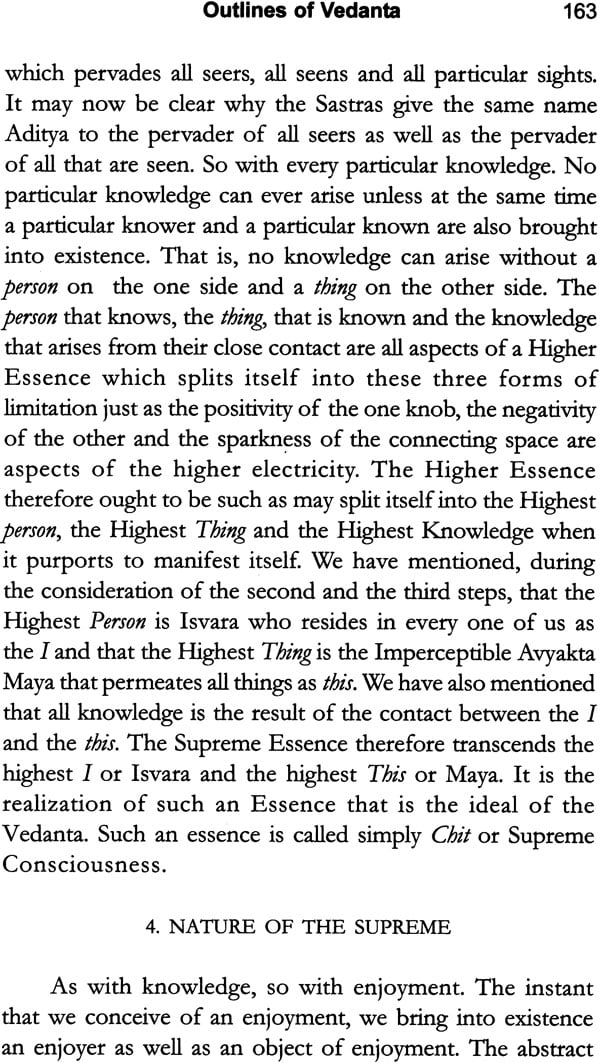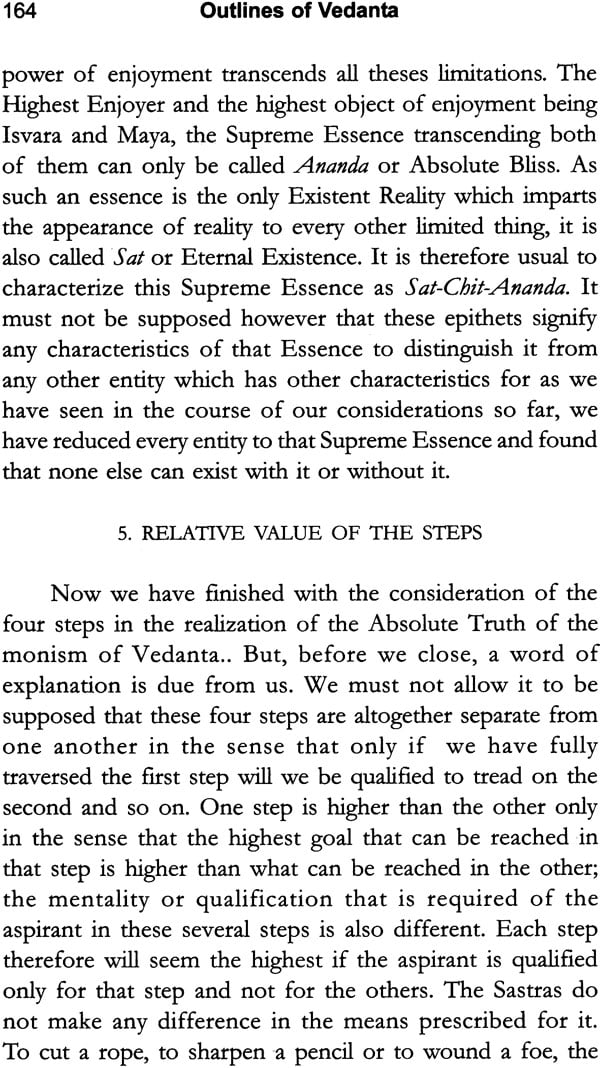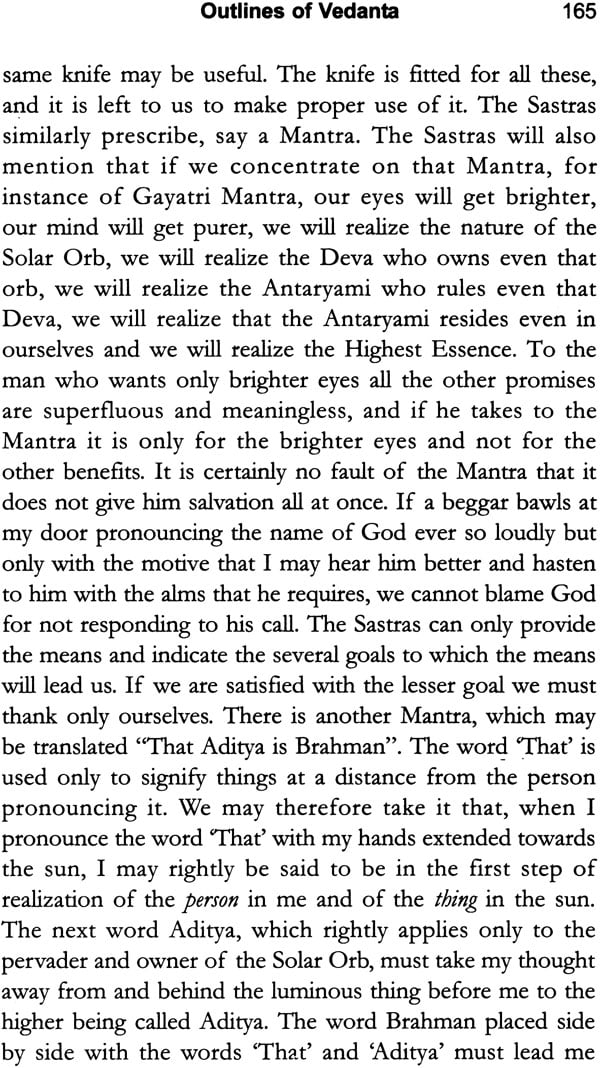
Outlines of Vedanta: Prajnanam Brahma Aham Brahmasmi Tattvamasi Ayamatma Brahma
Book Specification
| Item Code: | NAD043 |
| Author: | Jnanananda Bharathi |
| Publisher: | Sri K. Narayanaswami |
| Language: | English |
| Edition: | 2013 |
| Pages: | 166 |
| Cover: | Paperback |
| Other Details | 8.5 Inch X 5.7 Inch |
| Weight | 200 gm |
Book Description
The author who was known as Sri. R. Krishnaswami aiyar of Tiruneveli gave up the practice of law to devote himself to the study and exposition of the Sanatana (Hindu) Religion and philosophy of the Upanishads. He was also an ordent aspirant for the realization of the eternal truth of the oneness of Brahman and ultimately took up sayasa to experience that turiya state.
This book is a clear and lucid expositions of the Vedanta philosophy free from technicalities. The style and presentation are simple illustrations have been freely given to enable one and all to grasp the subject without any doubt.
This is an extremely valuable publication on a theme which must be of eternal interest to mankind — the relationship of man and the universe to the Eternal. The learned author expounds the subject in accordance with the tenets of the Vedanta, in particular as interpreted by Sankaracharya. According to the Vedas there was, in the beginning, only the Supreme Being called Brahman. Then the thought came to It — when or why or how, it will be futile to speculate- “I shall become many”. As a result, the five elements came into existence and then the animates, including man. Such is the story of the origin of the universe and it is thus narrated in this book:
“The Vedanta says that the Supreme Being was alone, One without a second. The Second less One who was pure consciousness devised to ‘cognise’, but there was nothing else but Himself so He had to cognize HimseW, in other words, He made Himself the object of His own cognition. In Sri Sankaracharya’s inimitable words, ‘The Highest Self who was pure consciousness looked at Himself as Himself and became therefore the I; from that arose the root of differentiation’ (Prabodhasudhakara, 95). He desired to become the many. But as there was nothing beside Himself, He had to create the many out of Himself alone”
Thus, according to the Upanishads the created things are all manifestations of the Supreme Being, as it existed before creation, or of the ‘formless Brahman’, as it is termed in Vedanta. From this three propositions follow.
(1) 1 the Soul, am Brahman.
(2) All This is Brahman.
(3) Brahman, the essence of the soul, is identical with Brahman the essence of the All.
This is what the Vedanta teaches and the main purpose of this work is to expound this concept and to show how it can be realized.
The first stage in this process, according to the author, is the knowledge of the distinction between a person and a thing (p.9O). A person is one who enjoys; a thing is one which is enjoyed. When we say that a person enjoys, who is it that really enjoys? Is it his flesh and bone that enjoy? No. They merely act on the urge of the senses. Therefore, it is the senses that enjoy and not the physical body, and accordingly the senses are the person and the body the thing. But then, it is the mind that moves the senses to action, and therefore the mind is the person and the senses the things in relation to it. Pursuing this line of reasoning, it is seen that it is the Jivatma or the soul that is the person and the rest of the creation, the Prapancha, is the thing.
The next step in this process of realization is the perception that all things in essence are one and the same, even though they arc different in names and forms. A table is different from a bench in name and form; but when once it is realized that they are both wood in different shapes, the sense of differentiation disappears. Following this line of thought it will be seen that all things are merely different manifestations of the five elements in different names and forms. The state is now set for the realization of the concept of a first cause from which both the Jivatma and the Prapancha have emanated. The formless Brahman or supreme being which in its pre-manifestation stage was one and indivisible omnipotent omniscient and omnipresent and Sat, Chit and Ananda became manifest as Jivatma and Prapancha when the thought came to it I shall be many and when that egoism is destroyed there is only the formless Brahman. This knowledge when realized must inspire the feeling of oneness of Jivatma and Prapancha with the Supreme being. But how is the concept to be realized? Not merely through experience because that can only be through the senses whose vision and capacity are alike limited nor by reasoning for as the Upanishad says how can you know him who is himself the knower it is here that faith came’s to our aid. Hence the importance of the Vedas.
The author next proceeds to examine where Karma rituals and upasana religious worship can help us in the realization of the godhead within us. Rituals are important he says because they instill into the mind a sense of duty and of sacrifice wean it away from attachment to matter and divert it in the direction of the spirit. The Sastric injuctions ordaining certain Karmas and prohibiting others have the effect of regulating our desires and inducing in us a state of non desire. This must help us to conquer Avidya and realize the oneness of the Jivatma with the Paramatma. Upasana again is very useful for it enables the devotee to realize that all this universe is only the manifestation of god. Each of the five elements can be regarded as a deva in itself and an intense devotion to any one of them enables the devotee to reach the Supreme Being who has created it as well as the other elements. Just as an ant traveling across any one of the five fingers can reach the hand and then have a comprehensive view of all the fingers so devotion to any one of the Devas will help in the realization that there is a supreme being behind who is the causa causans of the whole Prapancha religion says the author is the handmaid of philosophy and the Hindu religion both in its Karmakanda and Upasanankanda can be said to be Vedanta in action.
This is a modest attempt to present the basic principles of the Vedanta in a language fairly free from technicalities that great philosophy both in theory and in practice is too wide and elaborate to admit of its being compressed within the short compass of this book which aims only at a popular presentation of the subject. I have therefore confined myself to a consideration of the main principle of the absolute oneness of the reality and contented myself with a bare enunciation of the means by which that truth can be realized.
I have no doubt that to such of my readers as have made a study of the Vedanta the presentation made here will seem quite elementary and meager and capable of much improvement both in matter and in manner. But I may mention that this work is mainly intended for those who have passed through the process of modern education divorced as it is form our ancient Vedic culture and are yet eager to know the basic principles of our philosophy. If it succeeds in interesting them and in making them seek closer acquaintance with the original works on the Vedanta I shall consider my labor amply rewarded.
I must respectfully record here the deep debt of gratitude that I owe to my revered father Brahmasri G.Ramachandra Aiyar of the Tirunelveli Bar (later Sri Ramananda Saravati Svaminah) for the taste he infused in me from my boyhood for our philosophical religion and also for the careful training that he gave me in his natural desire to see me grow up a true Hindu. That I have not fulfilled all this expectations cannot take away from the magnitude of my obligation to him. I may mention also that he was kind enough to go through and approve of this book while in manuscript.
I shall be failing in my duty if I do not also respectfully acknowledge my indebtedness to the late Mahopadesaka Brahmsir S. Rajavallabha Sastrinath of the Tirunelveli Hindu College but for whose lucid expositions the Advaita literature whould have remained inaccessible to me.
| Foreword | |
| Preface | |
| Chapter I The Goal of life | 1 |
| Chapter II The Scope of Experience and Reasoning | 9 |
| Chapter III Faith | 19 |
| Chapter IV God and the Universe | 31 |
| Chapter V Some Epithets of God | 44 |
| Chapter VI The Means of Realization | 51 |
| Chapter VII The Bliss of the Self | 59 |
| Chapter VIII The Splitting of the Self | 66 |
| Chapter IX Vanity and its uses | 75 |
| Chapter X The Doctrine of Oneness | 83 |
| Chapter XI Persons and Things | 90 |
| Chapter XII Mistaken Identification | 100 |
| Chapter XIII Training for perception of Distinctness | 108 |
| Chapter XIV Limitations of the Supreme | 120 |
| Chapter XV Concentration | 131 |
| Chapter XVI Sense of Duty and Service | 144 |
| Chapter XVII Dedication and unification | 152 |
| Chapter XVIII The Realization of the Supreme | 161 |
